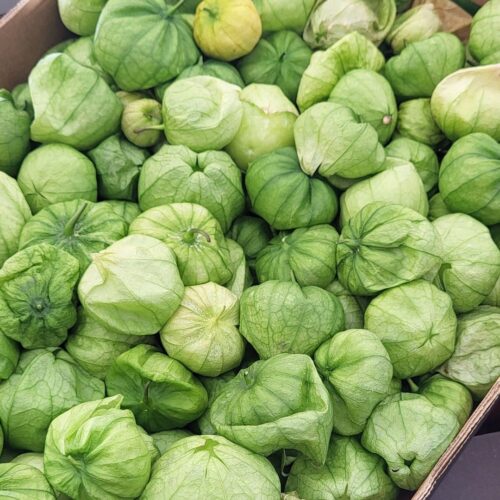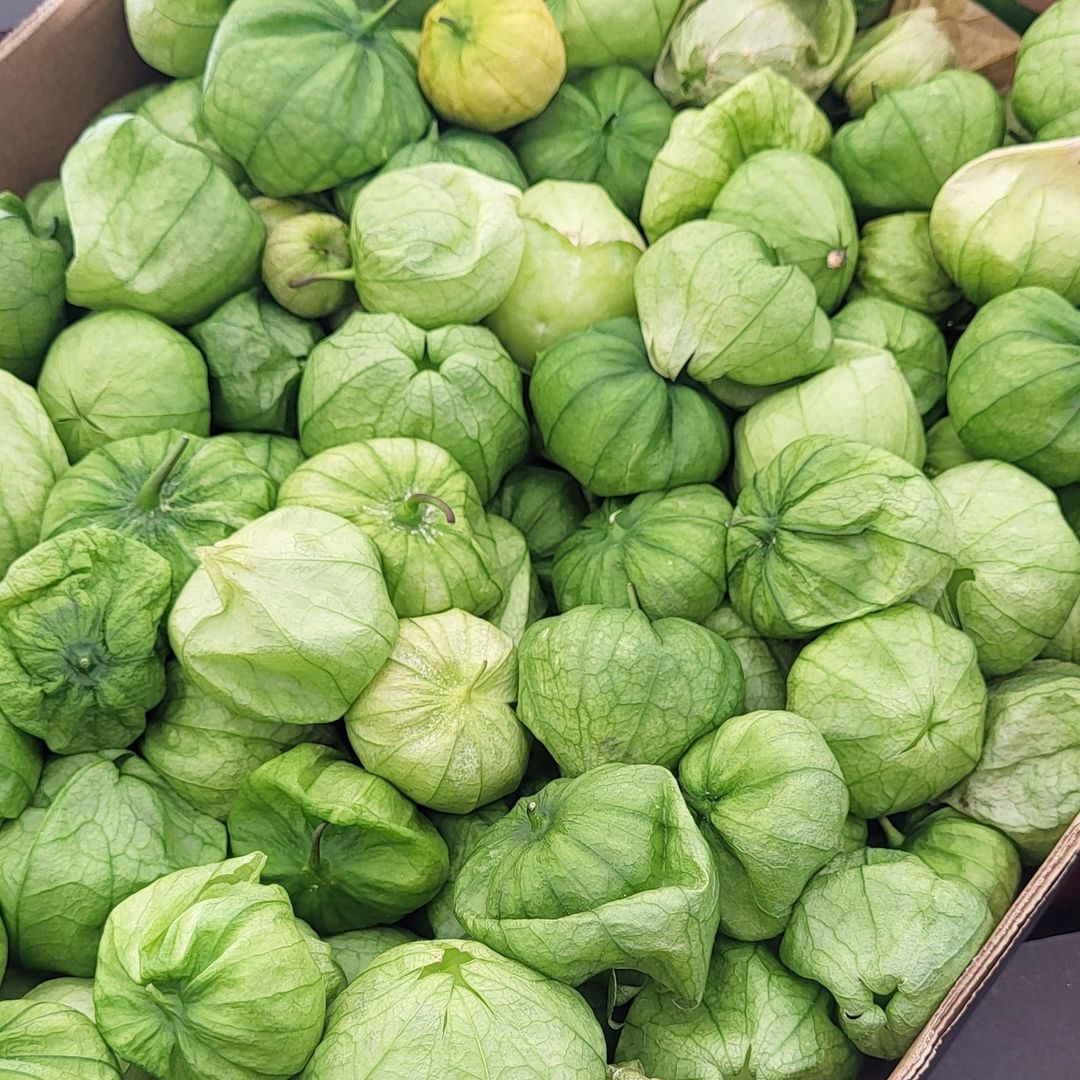Are you looking for the best Tomatillo Companion Plants? Then check out this post for good neighbors for these green lanterns.
When you choose the right Tomatillo Companion Plants, you will simultaneously decrease their vulnerability to certain pests and diseases. This process also enhances the garden space and improves soil nutrients and biodiversity. Read more about what to plant next to tomatillos and what to avoid in this post.
Best Companion Plants for Tomatillo

1. Cilantro
Sometimes, companion plants in the garden align perfectly with their culinary counterparts. Cilantro, which tastes amazing with tomatillos, has an aroma that repels pesky aphids. Additionally, it attracts beneficial insects that prey on aphids and cucumber beetles.
As an added benefit, trellised tomatillo plants can offer cilantro the shade it needs to withstand the summer heat. Cilantro often bolts when exposed to direct, hot summer sun, so pairing it with tomatillos or tomatoes creates a good companionship for both plants.
Remember that some bolted cilantro is beneficial, as its flowers provide excellent nectar for beneficial predators.
2. Yarrow
The pretty white blooms of yarrow benefit every companion plant in the garden. These medicinal blooms emit honey-like fragrances that sum up creamy white flowers over fern-like foliage. It entices the best pollinators.
It can attain a good height under favorable conditions, so plant around the edges of your tomatillo beds to prevent it from shading the main crop.
3. Onions
The Allium family, which includes onions, garlic, leeks, shallots, and scallions, is famous for its pungent odor that deters many pests. Onions, being low-growing and shallow-rooted, are particularly easy to crease in near tomatillo plants.
4. Garlic
The intense aroma of garlic can deter aphids. You can repel sap-sucking pests by planting a row of garlic bulbs near tomatillos and tomatoes. Additionally, the shallow roots and thin garlic stalks ensure they won’t interfere with your root zones of tomatillo or access to sunlight.
5. Basil
Basil is popular for its pest-repellant qualities; this fragrant herb deters hornworms by hiding the aroma of tomatillos, preventing the hornworm moth from locating them. Also, the low-growing nature of this herb allows it to efficiently cover the space beneath and beside trellised tomatillo plants, which would otherwise be bare soil.
Simply directly seed basil while transplanting tomatillos, or transfer baby basil seedlings near the trellised locations. Make sure to provide the tomatillo plants 10-12 inches of space from the basil plants. This will prevent overcrowding and ensure the basil doesn’t end up crowding your tomatillos.
6. Borage
Borage is effective in deterring tomato hornworms and other caterpillars. Its small, blue flowers attract pollinators, while its leaves can enhance soil quality or be added to compost. Apart from being a great companion to tomatoes and tomatillos, borage is also deer-resistant.
These plants can grow large, so it’s often best to plant them at the ends of your tomatillo rows rather than between them. Their showy blue flowers are also a visual delight!
7. Parsley
Sprinkling parsley leaves on tomatillo plants is believed to repel hornworms. This fragrant herb is an excellent pest deterrent. When allowed to flower, parsley can attract predatory wasps and hoverflies, helping to control pest populations.
8. White Alyssum
This classic companion flower is low-growing, beautiful, and highly attractive to predatory insects. It draws aphids away from tomatillos while attracting aphid-eaters such as ladybugs, lacewings, and predatory syrphid flies.
Plant alyssum at the edges of beds or in the shade of tomatillos for benefits.
9. Hot Peppers
Peppers are effective at preventing root rot in tomatillos and tomatoes. Additionally, their spicy scent repels pests. Low-growing bush varieties like habanero or cayenne peppers are ideal for planting alongside tomatillo rows, as they won’t compete with your plants.
10. Marigolds
Marigolds are not only beautiful but also make the perfect companion plant! They complement nearly every vegetable in the garden, repelling nematodes, mosquitoes, and beetles while attracting pollinators.
These pretty blooms also charm ladybugs, shower flies, and parasitic wasps, ensuring they will be nearby to snatch up any pesky aphids on your tomatillos. Additionally, marigolds add lively color to your garden.
11. Peas
Nitrogen-fixing legumes are an excellent choice for supporting heavy-feeding crops like tomatillos and tomatoes. While sugar snap peas can climb a tomatillo trellis, bush-type pea varieties make the best companions as they remain small, low-growing, and compact.
Peas form a strong relationship with soil bacteria and increase nitrogen availability for your tomatillos. Their flowers attract pollinators, and their crisp pods provide a tasty snack while you’re weeding or trellising your tomatillo patch.
12. Carrots
Carrots help in loosening the soil, which is advantageous for root growth. However, if the soil is extra clayey, planting tomatillos alongside carrots will be beneficial as it aids in breaking up the soil.
13. Tomatoes
Tomatillos and tomatoes prefer similar growing conditions, such as nutrients, soil, and sunlight. Similar growing needs make them compatible neighbors. When pollinators arrive in the garden, they keep the pests away from their flowers.
14. Mint
This fragrant, medicinal herb keeps the ants, aphids, and moths away from the tomatillo patch and makes great companion plants for tomatillos.
15. Nasturtiums
Nasturtiums keep the bugs away and attract beneficial pollinators to the garden. This plant also repels beetles and whiteflies from the area where you grow tomatillos.
Bad Companion Plants for Tomatillos
Brassicas
Cole crops from the Brassicaceae family (such as cabbage, kale, kohlrabi, cauliflower, and broccoli) can restrict the growth of tomatillo and tomato plants. Additionally, they may harbor fungal pathogens that could infect your tomatillo plants.
Potatoes
Tomatillos, tomatoes, and potatoes all belong to the nightshade (Solanaceae) family and attract similar pests. Potatoes, in particular, lure potato beetles, which can damage your tomatillo plants. To minimize pest issues, it’s best to keep these crops apart and rotate them regularly in the garden.
Fennel and Dill
These tasty herbs from the umbel family look great in the garden but emit a substance in the soil that can damage other plants. This substance can obstruct the growth of other plants.
In the wild, this trait benefits these herbs by allowing them to compete and grow large populations. However, it can be problematic in your tomatillo patch. It’s best to keep fennel and dill at a distance.
Corns
Corn is a bad companion plant for tomatillos because of its tall stature, which can shade them out. It also attracts aphids and other pests that could infest your tomatillo plants.



